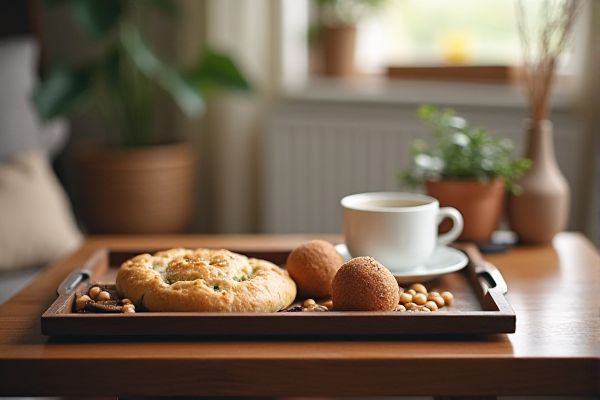
A lap tray is designed for general use with a flat, stable surface ideal for working, eating, or reading while seated, often featuring cushioned support for comfort. Breakfast trays are specifically crafted for serving meals in bed, typically including handles for easy transport and sometimes folding legs for stability; discover the key differences to choose the best option for Your needs in the full article.
Table of Comparison
| Feature | Lap Tray | Breakfast Tray |
|---|---|---|
| Primary Use | Supports laptop or work on lap | Holds food and beverages for breakfast |
| Design | Flat surface, often with padded base | Elevated legs for stability on bed |
| Material | Wood, plastic, or cushioned fabric | Wood, plastic, or metal |
| Portability | Lightweight, easy to carry | Usually bulkier but portable |
| Additional Features | Built-in mouse pad, wrist rest, storage | Foldable legs, cup holders |
| Typical Dimensions | Approx. 18x12 inches | Approx. 20x14 inches with legs |
Introduction to Lap Trays and Breakfast Trays
Lap trays and breakfast trays serve distinct purposes, with lap trays designed to provide stable support for laptops or meals while sitting, often featuring cushioned bottoms for comfort. Breakfast trays typically emphasize convenience and presentation, equipped with raised edges and foldable legs to serve food in bed efficiently. Both trays enhance ease of use and portability but differ in their specific functions and design features.
Key Differences Between Lap Trays and Breakfast Trays
Lap trays are designed primarily for use on your lap, featuring a flat surface with cushioned bottoms to provide comfort and stability when eating or working. Breakfast trays often have foldable legs, allowing them to stand securely on a bed or table, making them ideal for serving meals in bed. The key differences lie in their structure and intended use: lap trays prioritize portability with soft supports, while breakfast trays emphasize stability with rigid, foldable stands.
Common Materials Used in Tray Construction
Lap trays and breakfast trays commonly utilize materials such as wood, plastic, metal, and bamboo for durability and ease of cleaning. Wooden trays offer natural aesthetics and sturdiness, while plastic trays provide lightweight and cost-effective options ideal for portability. Your choice between these materials depends on desired durability, maintenance, and style preferences.
Design Features and Ergonomics
Lap trays typically feature a flat, stable surface with cushioned or contoured bottoms that conform to your lap, providing ergonomic support for comfortable use during prolonged periods. Breakfast trays often include raised edges to prevent spills and foldable legs designed for easy storage and elevation over a bed or couch. Both designs prioritize ease of use, but lap trays emphasize stability and comfort on the lap, while breakfast trays focus on convenience and elevation for dining.
Versatility and Intended Uses
A lap tray offers versatility with its flat surface and stable base designed for various activities like working on a laptop, writing, or eating meals comfortably anywhere. Breakfast trays tend to focus on serving food in bed or on the couch, often featuring handles and raised edges to prevent spills. Your choice depends on whether you need a multi-purpose lap workspace or a dedicated tray for serving meals.
Comfort and User Experience
Lap trays offer ergonomic support with padded bases and non-slip surfaces, enhancing comfort during extended use on soft furnishings. Breakfast trays typically feature foldable legs for height adjustment, providing stability and ease of access while seated at a table or bed. User experience varies as lap trays excel in portability and personalized use, whereas breakfast trays prioritize convenience and traditional serving functionality.
Space and Storage Considerations
Lap trays are typically compact and designed for personal use, making them ideal for small spaces and easy storage in drawers or under beds. Breakfast trays, often larger with foldable legs, offer more surface area but require dedicated storage space like closets or shelves. Your choice depends on available space and how frequently you need to store the tray when not in use.
Cleaning and Maintenance Tips
Lap trays and breakfast trays require regular cleaning to maintain hygiene and functionality; using a damp cloth with mild soap helps remove crumbs and spills effectively. For wooden trays, applying mineral oil periodically prevents cracking and preserves the finish, while plastic trays can be safely wiped with disinfectant wipes to ensure cleanliness. Your choice of tray should consider ease of maintenance to keep it looking new and lasting longer.
Pros and Cons: Lap Trays vs. Breakfast Trays
Lap trays offer portability and convenience, ideal for working or eating comfortably on a couch or bed, but they may lack stability on uneven surfaces. Breakfast trays typically feature foldable legs, providing a stable table-like surface that enhances mealtime ergonomics but can be bulkier and less versatile for activities beyond eating. Choosing between lap trays and breakfast trays depends on whether portability or stability is the primary need.
Choosing the Right Tray for Your Needs
Selecting the right tray depends on your specific use case; a lap tray offers a sturdy, ergonomic surface ideal for working, eating, or using a laptop comfortably while seated. Breakfast trays typically feature foldable legs and raised edges to prevent spills, making them perfect for serving meals in bed. Consider factors such as portability, stability, and intended use when deciding between a lap tray and a breakfast tray to ensure functionality and convenience.
 homyna.com
homyna.com